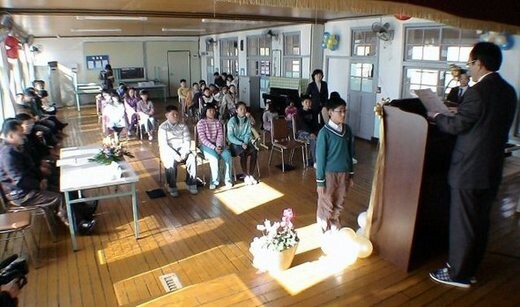hankyoreh
Links to other country sites 다른 나라 사이트 링크
Rural schools face severe student, budget shortages

Neungjubuk Elementary School in Hwasun, South Jeolla Province, is surrounded by tall trees as old as its history. But presently, the school’s two double-story buildings hold only about 50 students. The elementary school only has five grades instead of the usual six, because the 2nd and 3rd graders have been combined into one classroom.
Yun Jeong-hyeon, a teacher, said, "Once there were over 700 students. However, as people have left the farming village, the future of the school is at stake."
The situation is the same at nearby Doam Middle School. The school has 20 students in all, less than seven in each grade. This is because parents who can afford the commute take their children to be educated in nearby cities such as Naju and Gwangju. Six out of the 20 students at Doam are from families receiving government assistance.
The reality of education at the nation’s farming and fishing villages is becoming hopeless. The student body at rural schools is rapidly shrinking because more and more people have left Korea’s provincial villages to seek job opportunities elsewhere. The number of students in farming and fishing villages dropped by 10.4 percent between 1999 and 2004.
As a consequence, schools are being forced to close. Up to 2,266 schools in those villages have been closed out in the past decade. The future of about half of remaining 5,163 schools also is unclear, as the government plans to close schools with 100 or less students.
"It is said that the nation’s agricultural sector will completely disappear after four or five years owing to the free trade agreement with the United States," said Lee Jae-seok, a community leader in the Hampyeong of South Jeolla Province. "Under this situation, how could provincial schools exist?"
As a result of student scarcity, rural community schools are having trouble providing proper education. An increasing number of teachers work at more than one school, or teach subjects outside their area of expertise; students from two or three grade levels receiving lessons in the same classroom. Cash-strapped rural schools cannot bring in outside instructors or fund high-quality special programs or guest lecturers. It is also difficult for rural students to find afterschool academic institutes or other extracurricular activities, mainstays of their urban counterparts. In this way, children’s basic right to education is not being guaranteed.
In addition, the government has continuously reduced the number of teachers in rural communities. In South Jeolla Province alone, the government is going to cut 127 teachers in 2008.
Koo Sin-seo, head of the Korean Teachers and Education Workers’ Union branch in South Jeolla Province, said, "Schools in rural communities are true educational stages, where communication at a mutual level between teachers and students, or students themselves, is possible." Koo urged the government "to make laws to save education in rural communities and take various measures to support them, rather then phase out those schools by only considering economic logic."
Please direct questions or comments to [englishhani@hani.co.kr]
Editorial・opinion
![[Column] Park Geun-hye déjà vu in Yoon Suk-yeol [Column] Park Geun-hye déjà vu in Yoon Suk-yeol](https://flexible.img.hani.co.kr/flexible/normal/500/300/imgdb/original/2024/0424/651713945113788.jpg) [Column] Park Geun-hye déjà vu in Yoon Suk-yeol
[Column] Park Geun-hye déjà vu in Yoon Suk-yeol![[Editorial] New weight of N. Korea’s nuclear threats makes dialogue all the more urgent [Editorial] New weight of N. Korea’s nuclear threats makes dialogue all the more urgent](https://flexible.img.hani.co.kr/flexible/normal/500/300/imgdb/original/2024/0424/7317139454662664.jpg) [Editorial] New weight of N. Korea’s nuclear threats makes dialogue all the more urgent
[Editorial] New weight of N. Korea’s nuclear threats makes dialogue all the more urgent- [Guest essay] The real reason Korea’s new right wants to dub Rhee a founding father
- [Column] ‘Choson’: Is it time we start referring to N. Korea in its own terms?
- [Editorial] Japan’s rewriting of history with Korea has gone too far
- [Column] The president’s questionable capacity for dialogue
- [Column] Are chaebol firms just pizza pies for families to divvy up as they please?
- [Column] Has Korea, too, crossed the Rubicon on China?
- [Correspondent’s column] In Japan’s alliance with US, echoes of its past alliances with UK
- [Editorial] Does Yoon think the Korean public is wrong?
Most viewed articles
- 1‘We must say no’: Seoul defense chief on Korean, USFK involvement in hypothetical Taiwan crisis
- 2N. Korean delegation’s trip to Iran shows how Pyongyang is leveraging ties with Moscow
- 3‘Weddingflation’ breaks the bank for Korean couples-to-be
- 4Korea sees more deaths than births for 52nd consecutive month in February
- 5[Column] Park Geun-hye déjà vu in Yoon Suk-yeol
- 6Will NewJeans end up collateral damage in internal feud at K-pop juggernaut Hybe?
- 7[Column] Has Korea, too, crossed the Rubicon on China?
- 8Amnesty notes ‘erosion’ of freedom of expression in Korea in annual human rights report
- 9Samsung barricades office as unionized workers strike for better conditions
- 10[Column] The clock is ticking for Korea’s first lady